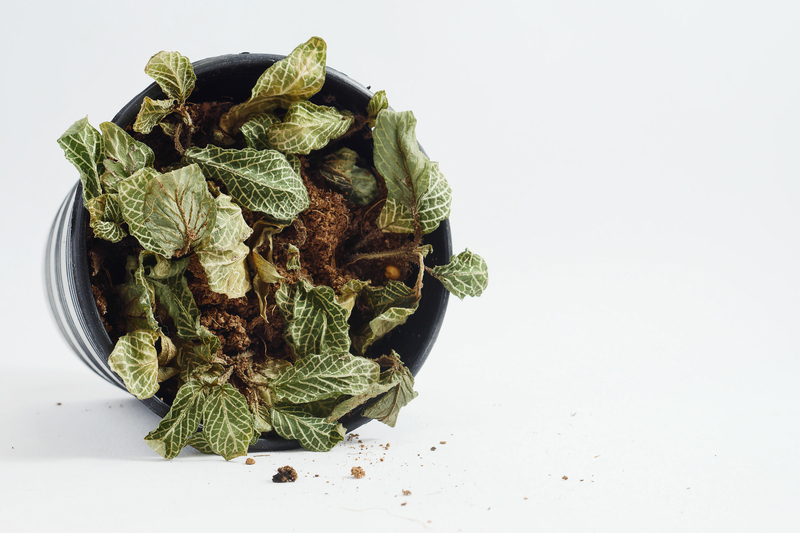Beyond Beauty: How Gardening Can Influence Climate Change
Posted on 22/08/2025
Beyond Beauty: How Gardening Can Influence Climate Change
Gardening is often celebrated for its aesthetic beauty, the tranquility it brings, and the fresh produce it yields. However, the role of gardening extends far beyond appearances. As humanity faces the urgent threat of climate change, gardening and climate change solutions are increasingly interwoven. In this comprehensive guide, we will delve into how gardens, both large and small, are powerful tools in mitigating environmental issues, fostering sustainability, and shaping a greener future for our planet.
Understanding the Link: Gardening and Climate Change
Climate change is primarily fueled by excessive greenhouse gas emissions, deforestation, and a decline in biodiversity. While these are global challenges, home gardeners and urban horticulturists play a crucial role in reversing these trends. Sustainable gardening introduces environmentally friendly practices, enhances carbon sequestration, and revitalizes ecological balance. The combined impact of millions of gardens worldwide can be a game-changer in the battle against global warming.
Key Ways in Which Gardening Helps Mitigate Climate Change
- Carbon Sequestration - Plants absorb and store carbon dioxide (CO2), acting as natural carbon sinks.
- Cooling Urban Environments - Gardens help lower temperatures and reduce the heat island effect in cities.
- Biodiversity Conservation - Native plants and pollinator gardens support vital wildlife and improve ecosystem resilience.
- Reducing Resource Consumption - Sustainable gardening minimizes water usage, plastic waste, and fossil fuel dependence.
- Promoting Soil Health - Healthy soils store more carbon and promote cleaner water cycles.
- Encouraging Local Food Production - Growing food at home reduces the carbon cost of transporting commercial produce.

The Science Behind Gardening and Climate Change
The relationship between gardening practices and climate change is rooted in biology, chemistry, and community action. Plants, through photosynthesis, extract CO2 from the atmosphere, using it to build roots, stems, and leaves. This process not only cleans our air but also stores carbon within the garden's biomass and soil. Sustainable gardens, with their layers of trees, shrubs, flowers, and ground covers, create multi-dimensional ecosystems that maximize carbon capture.
Soil as a Carbon Sink
Soil acts as an enormous carbon reservoir, holding more carbon globally than the atmosphere and all vegetation combined. When you practice sustainable gardening--by adding compost, avoiding unnecessary tilling, and planting cover crops--you improve the soil's structure and carbon-storing capacity. Conversely, poor gardening habits can deplete soil carbon and accelerate greenhouse gas emissions.
Sustainable Gardening Practices That Combat Climate Change
To harness the climate benefits of gardening, it's essential to adopt sustainable techniques. Here are some actionable methods that every gardener can implement:
1. Organic Gardening
- Use organic fertilizers and natural pest controls to avoid synthetic chemicals that harm pollinators and soil microbes.
- Incorporate compost and mulch to enrich soil and reduce landfill-bound organic waste.
2. Grow Native Plants
- Native species are adapted to local climates and require less water, fertilizer, and maintenance.
- They provide critical habitat and food for local wildlife, supporting biodiversity and resilience.
3. Reduce Water Usage
- Install rain barrels and drip irrigation systems to use water more efficiently.
- Prioritize drought-resistant plants that thrive with minimal rainfall, lessening the strain on freshwater resources.
4. Minimizing Use of Fossil Fuels
- Replace gas-powered mowers and trimmers with manual or electric alternatives.
- Practice no-dig or low-till gardening to avoid releasing stored soil carbon.
5. Composting
- Composting organic kitchen and garden waste reduces methane emissions from landfills and enriches your soil with essential nutrients.
- This sustainable practice helps sequester carbon and fosters healthier plant growth.
Maximizing the Positive Impact of Gardening on Climate Change
Transforming backyards, rooftops, and community parks into climate-resilient gardens involves more than adding plants. To fully realize gardening's environmental impact, here's how to maximize your efforts:
Create Layered Plantings
Strategically planting trees, shrubs, groundcovers, and wildflowers together mimics natural ecosystems. This increases carbon sequestration, optimizes shade, and supports a broader range of species--including pollinators vital to food crops.
Include Trees in Your Garden
Trees, particularly native and fruit-bearing varieties, are powerful tools in combating climate change. They provide significant shade, lowering local temperatures and energy demands for cooling buildings. Trees also absorb substantially more carbon than herbaceous plants.
Maintain Healthy Soil
Healthy soil teems with microorganisms that help trap carbon and reduce greenhouse gases. Practice crop rotation, add organic matter, and minimize soil disturbance to keep this ecosystem thriving.
Support Wildlife and Pollinators
Climate change disrupts vital animal and insect populations. By growing host plants and avoiding pesticides, you create a refuge for bees, butterflies, and birds--all critical allies in resilient food webs and crop production.
Urban Gardening and Its Role in Climate Mitigation
As cities expand, urban gardening for climate action becomes increasingly essential. Green roofs, vertical gardens, and pocket parks offer dense urban areas vital green infrastructure--helping regulate temperatures, absorb rainfall, and filter air pollution.
Benefits of Urban Green Spaces
- Temperature Regulation: Vegetation cools urban "heat island" zones, reducing the need for energy-intensive air conditioning.
- Rainwater Management: Gardens boost soil permeability, absorbing stormwater and preventing urban flooding.
- Improved Air Quality: Plants capture particulates and greenhouse gases.
- Community Engagement: Public gardens foster environmental awareness and sustainable living practices.
Composting: Turning Waste Into a Climate Solution
Composting is a cornerstone of eco-friendly gardening. Food scraps, leaves, and garden trimmings break down into compost, a potent soil enhancer. Instead of rotting in landfills (where organic waste releases methane--a potent greenhouse gas), compost enriches gardens, supports soil microbes, and locks more carbon in the ground.
- Methane Reduction: Home composted organic matter does not generate methane, unlike landfill waste.
- Soil Enrichment: Finished compost provides nutrients, supports water retention, and contributes to soil carbon storage.
Edible Gardens As a Climate Solution
Growing your own food does more than provide fresh produce--it actively shapes the environmental footprint of your meals. Transporting, packaging, and refrigerating commercial food are energy-intensive processes that add significantly to greenhouse gas emissions. By cultivating fruits, vegetables, and herbs at home, local gardeners can reduce food miles and dependence on industrial agriculture.
Tips for Lowering Your Food Carbon Footprint
- Emphasize seasonal, locally grown produce.
- Plant perennial crops that return yearly with less input.
- Use organic and heirloom seeds for diverse, sustainable harvests.
Gardening for Biodiversity: Protecting Nature's Balance
The loss of native plants and pollinators accelerates climate instability. Biodiverse gardens provide refuge for important species and boost ecosystem resilience. A diversity of plants supports different pollinators, pest-eating insects, birds, and small mammals--creating networks that help stabilize the environment in the face of global change.
- Butterfly and Bee Gardens: Choose nectar and pollen-rich flowers for these essential pollinators.
- Wildlife Corridors: Connect your garden with hedgerows and native shrubs to support animal movement.
Climate-Resilient Gardening: Adapting to a Changing Planet
As climate patterns shift, gardeners must adjust their methods to ensure their landscapes remain productive and sustainable. Resilient gardening techniques prepare your garden to thrive despite unpredictable weather, pest outbreaks, or resource shortages.
Resilient Gardening Strategies
- Diverse Plant Selection: Mix annuals, perennials, and trees to buffer against seasonal extremes.
- Water Management: Implement rain gardens and swales to capture runoff and minimize drought impacts.
- Soil Building: Use cover crops and green manures to protect and enhance soil health year-round.
Community Gardens: Climate Action on a Collective Scale
When individuals unite, their gardens transform into a powerful network for climate change mitigation. Community garden projects reclaim vacant lots, educate new gardeners, and provide fresh food to urban neighborhoods--directly reducing emissions associated with transportation and land misuse.
- Shared Resources: Pool compost, tools, and seeds for greater efficiency and lower costs.
- Educational Hubs: Community gardens teach sustainable techniques and spread environmental awareness throughout the neighborhood.

Overcoming Barriers and Misconceptions
Despite the proven benefits, some believe gardening's impact on climate change is too small to matter. However, every action, multiplied across thousands and millions of gardens, creates significant positive change. Improvements in soil health, urban cooling, and wildlife support scale up rapidly when communities embrace sustainable gardening practices.
Debunking Common Myths
- "My small garden won't make a difference." - In aggregate, the collective area of private gardens can surpass the size of cities, amplifying their environmental impact.
- "Sustainable gardening is too hard or expensive." - Many eco-friendly methods, like composting or mulching, are cost-effective and simple to implement.
Conclusion: Shaping the Future with Gardens
Gardening is much more than a visual delight. By helping regulate the climate, gardens fight global warming at the source. Through smart plant choices, organic practices, composting, and community engagement, anyone can be part of the solution. Whether you tend a few pots on a balcony or steward acres of land, your green space is a force for climate resilience.
As we move beyond beauty and embrace the powerful role that gardening plays against climate change, each seed sown becomes a step toward healing the planet. So dig in, nurture life, and know that your hands are shaping a sustainable future--one garden at a time.

